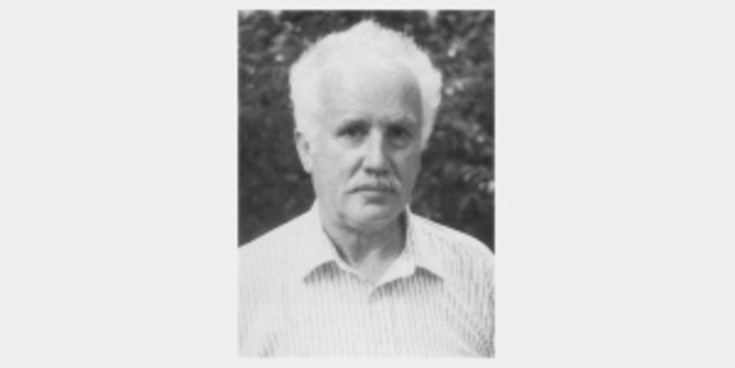Vorstand am Institut für Waldbau: 1991-1996
Karl J. Stoszek
Date and place of birth: August 22, 1935 in Buenos Aires/Argentina
Citizenship: USA
Curriculum
1954
Diploma in Business Administration; Junior College of Business Administration(Commercial Academy) in Orlova/Czechoslovakia 1958-59
Teaching Assistant in wildlife management and forest protection, School of Forestry, Agriculture and Forestry University, Brno/Czechoslovakia. 1959
Diploma Engineer of Forestry (B.S. and M.S. degree equivalent) with thesis on economicand organizational evaluation of logging systems in mountain terrain. School of Forestryat the Agricultural University in Brno/Czechoslovakia 1959 and 1962-63
Forest Management Planner with the Institute of Forest Management Planning,Prague/Czechoslovakia. Responsibilities included design of short- and long-termforest management plans for industrial forest enterprises; this included soil-vegetation classification, stand inventorization, and planning of reforestation,stand improvement and harvest-cut practices on a sustained yield, even-flow basis. 1963-64
Research Coordinator and Documentation Specialist for the Forest and WildlifeManagement Research Institute, Zbraslav/Czechoslovakia. Responsibilities included coordination of forestry research activities among forestry research organizations within "Eastern-Block Nations" and forestry extension. 1965
Land Surveyor for T. Schley, Civil Engineer in Solvang / California. 1965-68
Graduate Research Assistant, Entomology Department, Oregon State University in Corvallis/Oregon. 1968-72
Research Scientist, project leader in forest protection, Weyerhaeuser Forestry Research Centerin Centralia/Washington. Responsibilities included (1) designing and conducting researchon pest problems of intensively managed forest cultures with focus on impact assessmentand silvicultural prevention of pest damage (topics included: western pine-shoot borerin ponderosa pine plantations, spruce weevil in sitka spruce plantations, bark beetlesand thinnings, nursery pest problems, and cone and seed insects), (2) extension servicein protection – silviculture to forestry personnel in Weyerhaeuser operations and (3) servingas liaison on forest protection matters with public agencies and other corporate entities. 1972-74
Silviculturist for Weyerhaeuser Corporation in East Oregan Region, Klamath Falls/Oregon.Responsibilities included planning of reforestation and stand improvement practicesfor four hundred thousand acres of forest land in western pine-mixed conifer types,5 to 8 thousand acres planted yearly, about 14,000 acres of P.C. thinnings annuallyand about 20,000 acres per year fertilized with urea. 1973
Ph.D. degree; major in entomology, minors in silviculture and plant ecology.
Thesis: Bark Beetle – Host Tree Relationships. Oregon State University, Corvallis/Oregon. 1974-90
Professor of Silviculture and Forest Protection; Forestry Resources Department,College of Forestry, Wildlife and Range Sciences, University of Idaho, Moscow/Idaho. since 1977
Forestry Consultant (Ecosylvan Co.) 1979
Professor of Forest Resources 1987-88
Senior Forest Scientist, synthesis and integration U.S. Environmental ProtectionAngency´s project of the acidic deposition forest response progrqam at the Environmental Research Laboratory (EPA-U of I cooperative agreement) in Corvallis/Oregon. 1991-96
o. Prof and Head of Institute of Silviculture, University of Agricultural Sciences, Vienna.
Publications
Stoszek, K.J. and J.A. Rudinsky. 1966. Injury of Douglas-fir trees by maturation feeding of the Douglas-fir Hylesinus, Pseudohylesinus nebulosus (Coleoptera: Scolytidae) in Western Oregon. Canad. Entom. Vol. 99, No. 3. Stoszek, K.J. 1977. Factors influencing tree and stand susceptibility to Douglas-fir tussock moth attacks. ESA Symposium. The DFTM R & D Program. Bull. Ent. Soc. Am. Vol. 23, No. 3. Spomer, G. and K.J. Stoszek. 1978. Comparison of water potential in bole and needle tissues of lodgepole pine. Can. J. For. Res. 8:439-441. Stoszek, K.J., P.G. Mika, J.A. Moore and H.L. Osborne. 1981. Relationships of Douglas-fir tussock moth defoliations to site and stand characteristics in northern Idaho. For. Sci. Vol. 27, No. 3: 431-441. Stoszek, K.J., R.C. Chapman and H.J. McCarthy. 1986. Applied silviculture, stand structure and stocking studies. In Forest Management Inventories Handbook. Bureau of Insian Affairs, Portland/Oregon, Chapter 9. 69 pp. Stoszek, K.J. 1988. Prospect for management prevention of disturbances in forests of the mountain west. USDA Forest Service, Intermountain Research Station, General Technical Report INT-243, p. 267-274. Stoszek, K.J. 1988. Forests under stress and insect outbreaks. Northwest Environmental Journal, 4:247-261. Stoszek, K.J. 1990. Managing change through adaptive forestry. Focus on Research at College of FWR, University of Idaho, Moscow/Idaho. Stoszek, K.J. 1992. Adaptiver Waldumbau. ÖFZ 4/1992. S. 12-13. Stoszek, K.J. 1992. Adaptive Waldbewirtschaftung. ÖFZ 4/1992. S.14-16. Kuran G., K.J. Stoszek and R. Klumpp. 1995. Waldbauliche Sanierung bei Dauergradation der Kleinen Fichtenblattwespe. ÖFZ 3/1995. S.47-49.

